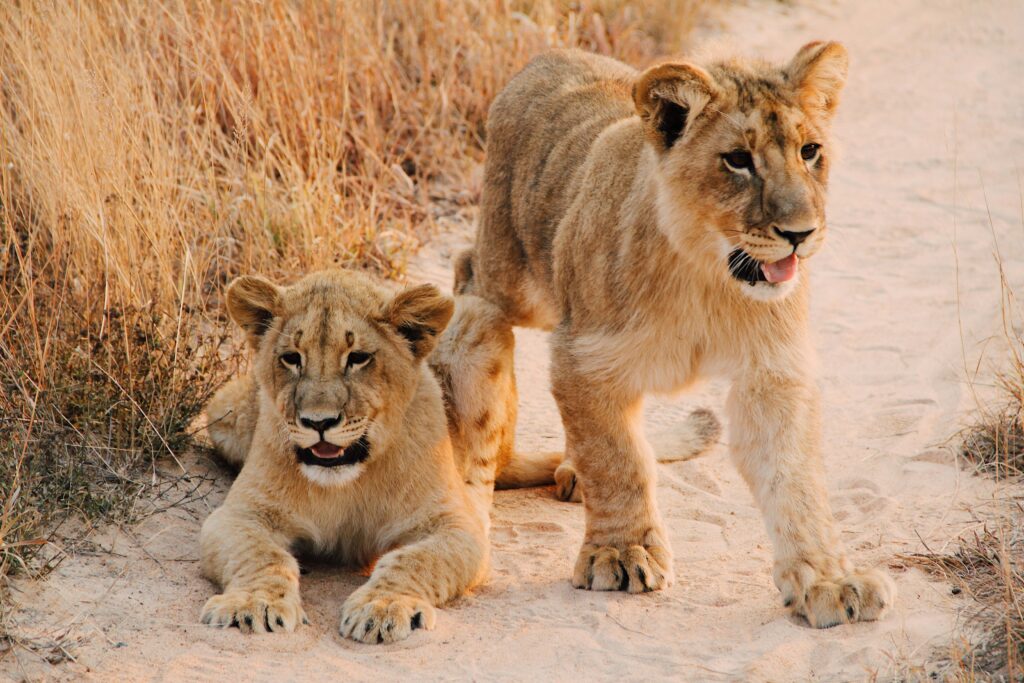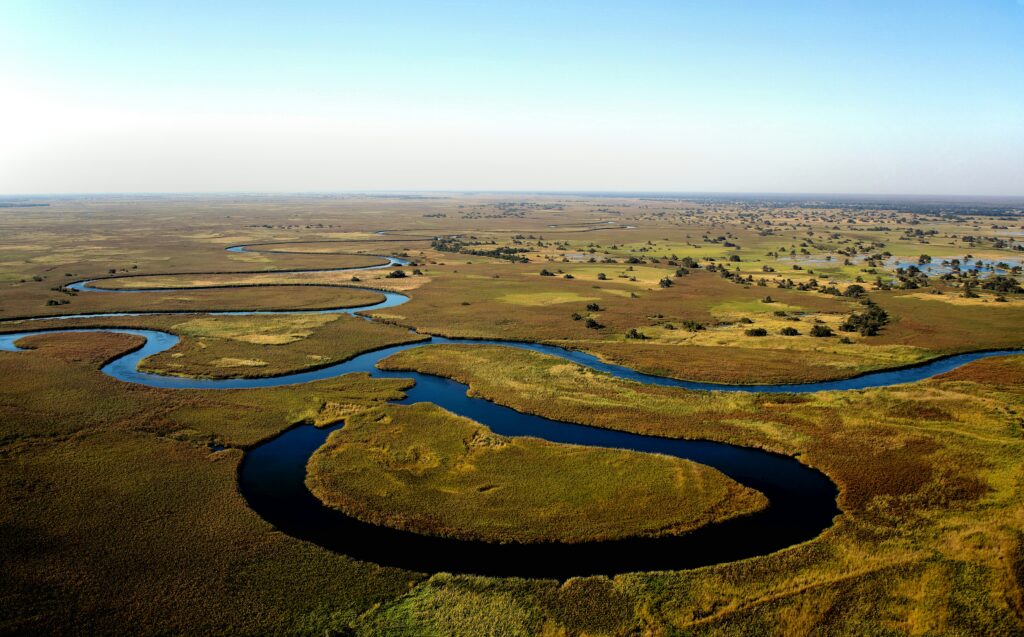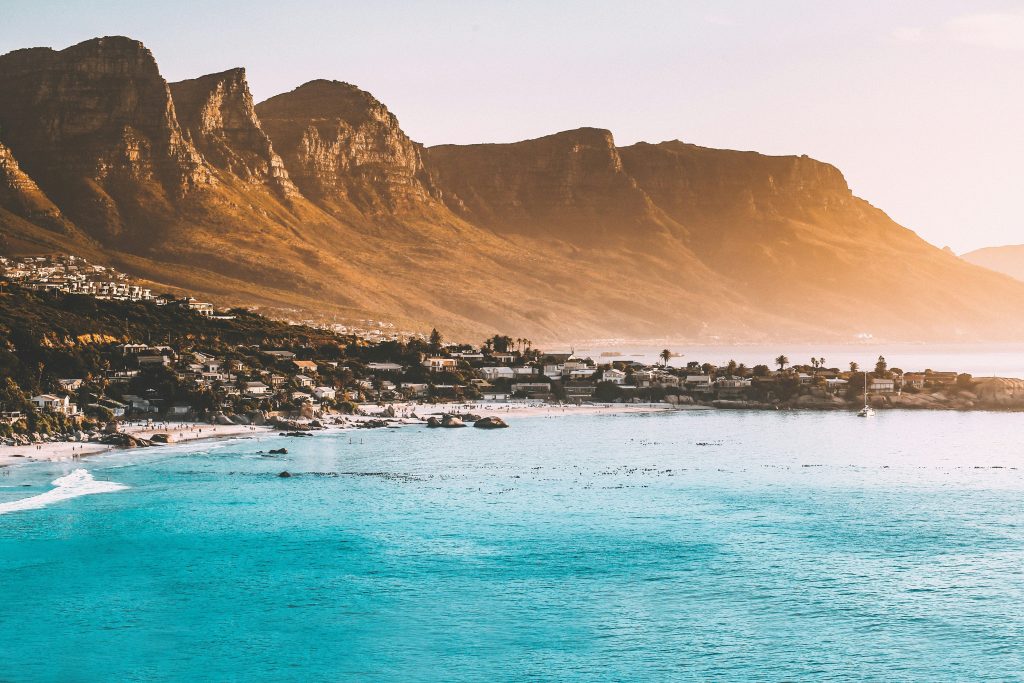Namibia is a place where the true meaning of ‘vastness’ can be experienced, not just understood. While the towering, unmatched sand dunes of the ancient Namib Desert are a highlight on most itineraries, this Southern African country—nestled between the Kalahari Desert and the Atlantic Ocean—offers so much more.

With its expansive, sparsely populated landscapes, Namibia is a land of dramatic skies and breathtaking scenery. Iconic destinations like Damaraland, the shipwreck-strewn Skeleton Coast, and the remote Kaokoveld all evoke a sense of isolation and adventure. Yet, hidden within these rugged areas are luxurious lodges offering serenity and comfort to adventurous travelers. And despite the seemingly barren landscape, Namibia is home to a surprising array of wildlife.
For wildlife lovers, Namibia is a dream come true. Etosha National Park, renowned for its waterholes teeming with animals and abundant predators, offers exceptional game viewing. In more secluded spots like Damaraland and Kaokoveld, you can encounter desert-adapted species, including elephants, black rhinos, giraffes, ostriches, oryx, and lions. These remarkable creatures have evolved to thrive in one of the harshest environments on Earth, making any sighting an unforgettable experience.
Namibia is perfect for wildlife enthusiasts, and its well-developed road network allows for easy self-drive safaris for independent travelers. The country’s remote, exclusive lodges offer luxury and privacy, making it an ideal destination for a romantic getaway. Meanwhile, families will appreciate Namibia’s safe, welcoming atmosphere, with plenty of activities and accommodations suited for all ages.
When deciding where to go in Namibia, you’ll find yourself spoilt for choice, with an abundance of wildlife-rich reserves, stunning landscapes, and charming towns. .
Namibia is a land of mystery and adventure, far beyond just the vast, sunbaked landscapes of the Namib Desert. This diverse country offers an array of breathtaking destinations, making any time the perfect time to explore.
With captivating wildlife reserves, striking scenery, and welcoming towns, choosing where to go in Namibia can be overwhelming—in the best way. While it’s impossible to see everything in one trip, certain must-visit spots deserve a place on your itinerary. Experience the iconic red dunes of Sossusvlei for the ultimate Namib Desert adventure, and head to Etosha National Park for an unforgettable safari teeming with wildlife.
1. Namib Desert and Sossusvlei – Majestic Dunes and Hidden Wildlife
Deep in the heart of the Namib—the world’s oldest desert—lies one of Africa’s most enchanting destinations: Sossusvlei. Famous for its towering red sand dunes, some reaching up to 300 meters, this surreal landscape is the crown jewel of an endless sea of sand. But the Namib Desert holds more than just the iconic Sossusvlei Dunes. Stay at one of the area’s exceptional lodges and uncover the hidden wildlife, breathtaking vistas, and otherworldly beauty of this hauntingly stunning terrain, much of which is protected within Namib-Naukluft National Park. As one of Namibia’s must-see destinations, Sossusvlei promises an unforgettable adventure.
2. Etosha National Park – Prime Game Viewing and Iconic Predators
As one of Africa’s largest and most renowned conservation areas, Etosha National Park is the ultimate destination for an unforgettable Namibia safari. Nestled in the country’s remote north, this wildlife haven feels wonderfully secluded yet remains easily accessible via well-maintained gravel roads, even for standard vehicles.
Etosha’s defining feature is its vast salt pan, surrounded by diverse landscapes that support an incredible array of wildlife. Here, you’ll encounter classic African icons like elephants, zebras, and giraffes, alongside desert-adapted species such as black rhinos, gemsbok, and springbok. Predators, including lions, hyenas, and cheetahs, are frequently spotted, especially around the park’s legendary waterholes—best visited between May and October, the prime season for wildlife viewing.
While accommodation is available within the park, staying at one of the exclusive private reserves on its outskirts offers a more luxurious experience, complete with private game drives and a range of safari activities.
3. Fish River Canyon – Dramatic Scenery in Namibia’s Southern Region
As the second largest canyon in the world, Fish River Canyon is a breathtaking marvel and a must-visit destination in Namibia. Its sheer size is truly staggering; standing at its edge, you’ll be awed as the flat, arid plateau suddenly plunges nearly 500 meters into a stunning 160-kilometer labyrinth of rock formations.
Be sure to have your camera ready, as the vibrant hues of purples, greys, and pinks—shaped by the erosive forces of the Fish River over millions of years—create a mesmerizing landscape. You can take in the awe-inspiring views from the comfort of your car or immerse yourself in the experience by hiking along the Fish River Canyon trail.
4. Damaraland – Stunning Scenery and Desert Wildlife
Damaraland, an inland region characterized by rugged mountains, gravel plains, and seasonal rivers, is a must-visit destination for those seeking unspoiled natural beauty in Namibia. Renowned for its breathtaking landscapes, this enchanting area offers spectacular views by day, while the night sky comes alive with a dazzling display of stars.
Located in the Kunene Region of northwestern Namibia, Damaraland is rich in both cultural history and geological wonders, showcasing ancient Bushman art and unique rock formations. The region is also home to an impressive array of wildlife, including desert-adapted elephants, black rhinos, and various species of antelope, making it a wildlife enthusiast’s paradise.
Hidden away in serene spots, intimate lodges provide comfortable accommodations and serve as perfect bases for exploring the diverse landscapes and attractions during your unforgettable Damaraland adventure.
5. Skeleton Coast – Shipwrecks, Seal Colonies and Utter Isolation
The Skeleton Coast National Park, known for its haunting shipwrecks that dot the shoreline, offers more than just tales of maritime misfortune. While these battered vessels have given Namibia’s northern coast its eerie name, the region boasts a rich ecosystem teeming with life. Massive seal colonies thrive here, providing food for scavengers like brown hyenas and jackals, while lush inland river valleys are home to a diverse array of animals and birds, making it one of Namibia’s top attractions.
For travelers seeking a genuine off-the-beaten-path experience, the Skeleton Coast promises complete isolation, tranquility, and breathtaking scenery. The area features a select few exclusive lodges, including the remarkable Shipwreck Lodge, which perfectly embodies the spirit of this unique landscape.
6. Swakopmund – Coastal Holiday Town and Ideal Safari Stopover
Swakopmund is the perfect stopover and a great place to stock up during your Namibia travels. This charming coastal town beautifully merges its German colonial heritage with a vibrant African flair. Often shrouded in early morning sea fog, Swakopmund sits at the meeting point of the Namib Desert and Namibia’s Atlantic coast, making it an ideal base for desert excursions.
The town offers a plethora of adventure and leisure activities, along with many local attractions that showcase the region’s unique character. When planning your trip, don’t miss the opportunity to include Swakopmund in your itinerary for an immersive seaside experience, where you can discover intriguing sights around every corner.
7. Lüderitz and Kolmanskop – Coastal Isolation and Iconic Ghost Town
The ghost town of Kolmanskop is a place that feels like it’s straight out of a dream or a fantasy film, making it one of the must-visit destinations in Namibia. Its unique history and the stunning photo opportunities presented by sand-covered, abandoned mansions create an unforgettable experience. This striking location is a perfect example of nature reclaiming its space, and it’s a sight that every traveler should witness.
After exploring Kolmanskop, consider making a day of it by enjoying lunch in Lüderitz, the charming seaside town just a short drive away. Lüderitz offers its own array of attractions, allowing you to fully immerse yourself in the region’s rich history and stunning landscapes.
8. Caprivi Strip – Wetlands, Wildlife and Birdwatching
Once considered the forgotten frontier of Southern Africa, the Caprivi Strip—now known as the Zambezi Region—has transformed into one of the region’s premier wildlife destinations. This area is predominantly made up of conservation zones and offers a wetland experience that rivals the famous Okavango Delta.
During your visit, you can stay at one of the fantastic lodges in the region and embark on guided game drives and river cruises. The Caprivi Strip is an excellent destination for spotting elephants, buffalo, hippos, and various antelope species, making it a must-see for wildlife enthusiasts. Additionally, it’s renowned for some of the best birdwatching opportunities in Namibia, attracting avid birders from around the world.
9. Windhoek: Start or End Your Safari in Africa’s Most Accessible Capital
Clean, safe, and welcoming, Windhoek stands out as one of Africa’s favorite capital cities and ranks among Namibia’s top attractions. Its central location and international airport make it the perfect base to begin or conclude your spectacular Namibia safari. Take the opportunity to stock up on supplies, catch up on emails, and unwind before or after your adventures.
Windhoek offers a wide range of accommodations, from international hotel chains to charming boutique lodges, ensuring you have a comfortable stay. Plus, you’ll find plenty of dining and drinking options to satisfy any craving. What more could you ask for?
When is the best time to visit namibia?
The best time to visit Namibia for game viewing, particularly in Etosha National Park, is during the dry winter months from May to October. With clear skies, low malaria risk, and animals gathering around water sources, this period offers optimal conditions for wildlife sightings. However, be prepared for chilly nights in June and July, while September and October can bring intense heat. From November to April, the summer rains transform the landscape into lush greenery, although they can sometimes cause floods in the desert.
The Best Time to Visit Namibia: A Month-by-Month Breakdown
January – Summer Rains and Vibrant Birdlife
January brings the peak of summer, with hot temperatures and occasional heavy afternoon showers. The rains rejuvenate the landscape, turning Etosha National Park into a lush, green paradise. While the dense vegetation can make wildlife spotting more challenging, birdwatchers are in for a treat—flamingos arrive in full pink splendor. However, the Zambezi Region (formerly Caprivi Strip) experiences heavy rains, leading to flooding and an increased risk of malaria, making it a less favorable destination during this time.
February – Calving Season in Etosha
February is typically the hottest and most humid month, with frequent rainfall. Despite the wet conditions, this time of year offers unique experiences—Etosha enters calving season, giving lucky visitors the chance to witness newborn animals taking their first steps. The abundance of fresh vegetation attracts herbivores, which in turn draws predators, creating exciting game-viewing opportunities.
March – Lush Landscapes and Cooler Nights
As the rainy season begins to taper off, Namibia’s landscapes remain beautifully green. Temperatures stay warm during the day but start to cool at night, making for more comfortable conditions. While wildlife remains somewhat dispersed due to the abundance of water, the scenery is breathtaking, providing excellent opportunities for photographers and nature lovers.
April – Stunning Scenery and Clearer Skies
April is a photographer’s dream, with crisp air, stunning cloud formations, and landscapes still refreshed from the rains. Wildlife viewing gradually improves as water sources begin to shrink, and animals start to gather at more predictable locations. Though not yet peak season for safaris, the scenery alone makes April a fantastic time to visit.
May – The Start of Peak Safari Season
With the arrival of winter, Namibia enters its prime safari season. Rainfall is minimal, humidity drops, and wildlife becomes easier to spot as animals start gathering around permanent water sources. The crisp, dry air and clear skies create excellent conditions for game drives, making May one of the best times to visit Namibia for a classic safari experience.
June – Cool Temperatures and Exceptional Game Viewing
June brings cooler weather, especially at night, with some desert regions experiencing near-freezing temperatures. However, the days remain pleasant, with clear blue skies. The dry landscape makes spotting wildlife significantly easier, as animals congregate around waterholes. The beginning of the month is still relatively quiet in terms of tourist numbers, but by the end of June, the peak travel season is in full swing.
July – The Ultimate Safari Month
July is the driest month of the year and one of the best times for a Namibian safari, especially in Etosha National Park. With water becoming scarce, large herds of elephants, zebras, giraffes, and antelopes gather at waterholes, offering incredible wildlife sightings. Predator activity increases as they take advantage of the concentration of prey. As this is one of the most popular months for travel, booking accommodations in advance is highly recommended.
August – Peak Season and Stunning Desert Adventures
August is the heart of Namibia’s peak travel season, with cool, dry conditions ideal for outdoor adventures. The country’s vast landscapes provide spectacular opportunities for hiking, safaris, and desert exploration. One of the highlights of this month is the blooming of wildflowers in the Ai-Ais Richtersveld Transfrontier Park, transforming the arid landscape into a vibrant, colorful spectacle.
September – Prime Wildlife Viewing
With temperatures gradually rising and the dry season at its peak, September is an exceptional month for safaris. Wildlife remains concentrated around water sources, offering remarkable game-viewing opportunities. The clear skies and moderate temperatures make this one of the most pleasant times to explore Namibia’s diverse national parks.
October – Transition to Warmer Weather and Whale Watching
October signals the end of winter and the start of rising temperatures. While occasional rain showers may begin to appear, the skies remain mostly clear, making for excellent stargazing conditions. This is also the perfect time to visit the coast, where southern right, minke, and humpback whales can be spotted off the shores of Walvis Bay as they migrate through the Atlantic waters.
November – The Return of the Rains and Birdwatching Delights
November marks the beginning of the rainy season, bringing relief from the dry conditions. While the rains can be unpredictable, they bring dramatic thunderstorms and the return of lush greenery. This is also a fantastic month for birdwatching, as thousands of flamingos arrive in Swakopmund, gathering in brilliant pink flocks around the lagoons.
December – Summer Rains and Festive Safaris
December sees the landscape fully rejuvenated by summer rains, making for stunning scenery. While game viewing remains excellent in Etosha, the influx of migratory birds makes this a prime time for birdwatching enthusiasts. The holiday season brings a surge of visitors, as travelers flock to Namibia for an unforgettable end-of-year safari adventure.
EXCITED TO PLAN YOUR BOTSWANA ADVENTURE?
Connect with an experienced traveler! Reach out to one of our Africa Safari Experts to create a personalized Namibia itinerary tailored just for you.
History and Economy
Namibia, a country defined by vast deserts and rugged mountains, boasts a surprisingly rich and intricate history. Originally inhabited by the San Bushmen, the land was later settled by African herders and farmers before European influence began in the late 1800s. A brief period under German colonial rule was followed by 70 years of South African control. Namibia’s fight for independence unfolded against the backdrop of the Cold War, and it wasn’t until 1990 that the country gained its freedom.
The country’s economy is heavily driven by its mining sector, with valuable deposits of uranium, diamonds, and other precious metals. Mining contributes a quarter of Namibia’s revenue, while tourism plays a significant role in its economy, providing 18% of the total employment. Future development of offshore gas resources holds promise for further economic growth.
People and Culture
Despite its vast size—twice the size of Germany—Namibia is sparsely populated, with just 2.1 million residents, making it the second least densely populated country in the world. The majority of Namibians are Ovambos, with substantial minorities including Herero, San Bushmen, Germans, and Afrikaners. Christianity is the dominant religion, though traditional beliefs are still practiced in rural areas.
English serves as the official language, but many Namibians also speak German and Afrikaans, making communication easy for speakers of these languages. While much of Namibia’s modern culture mirrors that of South Africa, the country is also home to some of Africa’s most impressive rock art and the Himba people, who continue to live traditionally in the Kaokoveld, adorning themselves with animal fat and natural pigments.
Landscape and Wildlife
Most of Namibia’s population resides on the fertile central plateau, but it’s the country’s dramatic deserts and unique environments that define its landscape. The Namib Desert, stretching to the cold Atlantic coast, is the world’s oldest desert and is famous for the towering dunes of Sossusvlei. The northern regions are characterized by open woodlands and grassy savannahs, while the Caprivi Strip (now known as the Zambezi Region) offers expansive wetlands—a relic from the colonial period.
Environmental conservation is a constitutional priority, with around 15% of the country dedicated to national parks and reserves. Namibia’s wildlife is incredibly diverse, with species like elephants and lions adapting to the harsh desert conditions. Etosha National Park stands out as the country’s premier wildlife destination, offering spectacular game viewing with its famous floodlit waterholes and its role as a sanctuary for endangered species like the black rhino and cheetah.
Other wildlife hotspots include the Caprivi reserves, known for bird watching and large herds of elephants and buffalo, and the unique Waterberg Plateau, a sanctuary for classic savannah animals.
Namibia’s landscapes, wildlife, and cultural richness make it a truly unique destination for travelers and nature lovers alike.
Excited to plan your namibian Adventure?
Connect with an experienced traveler! Reach out to one of our Africa Safari Experts to create a personalized Namibia itinerary tailored just for you.
Get in Touch with Our Namibia Experts
Do you have questions about exploring the breathtaking landscapes, unique culture, and diverse wildlife of Namibia? Our dedicated team of experts is here to help! Whether you’re seeking information on the best safari experiences, travel itineraries, or tips for your trip, we’re just a message away.
Don’t hesitate to reach out with any inquiries, and let us assist you in planning the adventure of a lifetime in this remarkable country. Your unforgettable Namibian journey awaits!


Ready for Your Adventure?
Contact us today to begin planning your unique African safari experience.










